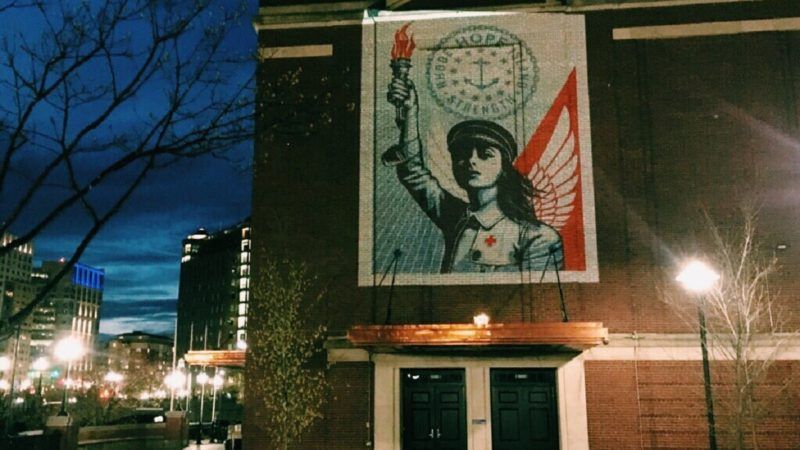The Outrage Over Rhode Island's State-Funded Coronavirus Art Is Overblown
The similarities between the image and totalitarian propaganda of old are unmistakable. But we all have bigger things to worry about right now.

At long last, Rhode Island's state government has art to match its coronavirus response.
On Saturday, Rhode Island Gov. Gina Raimondo (D) unveiled the Rhode Island Angel of Hope and Strength, which is intended to inspire people whose lives have been disrupted by the state's COVID-19 outbreak and subsequent shutdowns of most economic and social life.
We thank our frontline workers who are keeping Rhode Islanders safe every day. Thank you, Shepard Fairey, for creating this beautiful image of hope. We'll get through this together. pic.twitter.com/QIaKbYhHp3
— Gina Raimondo (@GovRaimondo) April 26, 2020
It was an honor when R.I. Governor Gina Raimondo reached out to me to create an image to lift the spirits of Rhode Islanders whose lives have been disrupted by the Coronavirus crisis. Visit: https://t.co/JD4xjEVSFI for details. pic.twitter.com/8i2AwexXp1
— Shepard Fairey (@OBEYGIANT) April 27, 2020
The image was created by Shepard Fairey—the artist behind the iconic Obama 'Hope' image and an alum of the Rhode Island School of Design—who said in a post on his website that he was solicited by Raimondo to produce an uplifting image that incorporated the state's "working-class roots" and paid homage to its healthcare and public safety workers.
However, the image he produced has irked some folks in the state. As the Providence Journal reports, Rhode Island conservative social media pages were filled with comments about the image's similarity to the iconography of totalitarian regimes. The Journal also noted criticism from the local art community who denounced Raimondo's decision to commission a California-based artist for the work.
The Rhode Island Center for Freedom & Prosperity, a conservative think tank, issued a press release in which it drew similarities between the image and propaganda images of Soviet dictator Joseph Stalin and Adolph Hitler.
The image is "a bastardization of the Statue of Liberty wearing a communist China-type cap and tunic, in a layout reminiscent of posters supporting fascist dictatorships of the past," reads the Center's press release.
"Consistent with her authoritarian plans to unilaterally impose harsh dictates on businesses, employees, and individuals during our state's recovery process, the Governor, unbelievably, is asking us to accept such an overtly anti-American symbol of repression," said Mike Stenhouse, the Center's CEO.
The Center has called for businesses to be allowed to reopen, provided appropriate social distancing measures are put in place.
Rhode Island's coronavirus response made headlines last month when the state National Guard began going door to door looking for New Yorkers in violation of a directive requiring travelers from out of state to register with the government and self-quarantine for 14 days, a policy that drew the ire of the Rhode Island chapter of the American Civil Liberties Union.
Like many other jurisdictions across the U.S., Rhode Island has also ordered all non-essential retail businesses to close and instructed residents to stay home unless they are leaving the house to get food, medicine, gas, or are going to work. This order is currently in effect until May 8.
Given the inordinate number of restrictions placed on people's liberties right now—many of which have lasted past their expiration date, and some of which should never have been implemented in the first place—it's a little difficult to get worked up by the thematic choices in Rhode Island's state-sponsored artwork.
That said, it's hard not to see the Angel of Hope's stark similarities to propaganda images of old. While a different picture or artist might have resulted in less controversy, the state government should probably focus its attention on finding a safe way to restore its economy.
Rent Free is a weekly newsletter from Christian Britschgi on urbanism and the fight for less regulation, more housing, more property rights, and more freedom in America's cities.


Show Comments (73)